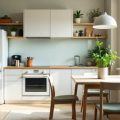Understanding British Bed Sizes and Standards
If you are planning to invest in a new bed, understanding the nuances of British bed sizes is essential. Unlike some other countries where sizing can be more standardised, the UK has its own unique set of conventions. The main options you will encounter on the British high street and online retailers are Single, Double, King, and Super King. A standard Single bed measures 90cm by 190cm, making it ideal for children’s rooms or compact guest spaces. The Double, at 135cm by 190cm, is the most common choice for couples with limited bedroom space. For those seeking extra comfort, a King size offers 150cm by 200cm, providing additional legroom and width. At the top end, the Super King boasts a generous 180cm by 200cm, perfect for spacious master bedrooms or anyone who values luxurious sleeping quarters. It’s important to note that these measurements reflect mattress sizes; bed frames may add extra width or length. When choosing your new bed, always check both frame and mattress dimensions to ensure a proper fit within your bedroom layout. Navigating these British sizing conventions allows you to make an informed decision—whether you’re upgrading for style, comfort, or both.
2. Comparing Bed Frames: Materials, Styles, and Practicality
When it comes to choosing the ideal bed for your British home, the frame is more than just a structural necessity—it’s central to both comfort and the overall aesthetic of your bedroom. The UK market favours a variety of materials and styles, each with its own merits and drawbacks. Below, we break down the most popular options, highlighting their suitability for different lifestyles and design preferences.
Popular Bed Frame Materials in the UK
| Material | Key Features | British Style Notes | Practicality |
|---|---|---|---|
| Wood | Classic look, durable, warm tones | Favoured for traditional or cottage interiors; oak and pine especially popular | Sturdy, can include drawers or ottoman storage; heavier to move |
| Metal | Sleek lines, often powder-coated finishes | A staple in modern and Victorian-inspired rooms; black or brass finishes are trending | Lightweight, easy to assemble; may squeak over time but generally long-lasting |
| Upholstered | Padded frames with fabric/leather covers | Loved for contemporary and boutique hotel vibes; grey velvet and tweed are current favourites | Comfortable headboards; can feature built-in storage but require regular cleaning |
Design Preferences: What’s Trending in Britain?
The British approach to bedroom style balances timeless elegance with practicality. Wooden frames—especially those made from sustainably sourced oak—are seen as investments that age beautifully. Metal beds evoke either classic Victorian charm or clean-lined minimalism, depending on finish. Upholstered frames, meanwhile, continue to rise in popularity thanks to their plush look and tactile appeal; they’re often chosen for master bedrooms aiming for a touch of luxury.
Storage Solutions: Making the Most of Space
With many UK homes prioritising efficient use of space, integrated storage is a significant consideration. Ottoman beds (where the mattress lifts up to reveal a hidden compartment) and divan bases with drawers are especially practical. These solutions help keep bedrooms tidy without sacrificing style—a key concern in urban flats or period properties where wardrobes might be limited.
Summary Table: Storage Options by Frame Type
| Frame Type | Common Storage Features |
|---|---|
| Wooden Bed Frames | Under-bed drawers or raised clearance for boxes/baskets |
| Metal Bed Frames | Typically raised legs allow use of under-bed storage boxes |
| Upholstered Beds | Ottoman lift-up base or integrated side drawers |
Selecting a bed frame that aligns with your lifestyle means weighing these materials and features against your personal taste and space constraints. In the following sections, we’ll delve further into mattress choices and finishing touches that complete the perfect British bedroom.

3. Mattress Matters: Comfort, Support, and Local Preferences
When it comes to choosing the perfect bed, the mattress is at the heart of both comfort and style—especially for British sleepers who often have particular preferences shaped by local climate and living spaces. The UK market offers a variety of mattress types, each with its own merits.
Pocket Sprung Mattresses
Pocket sprung mattresses are a traditional favourite in Britain, renowned for their supportive structure. Each spring is encased in its own fabric pocket, allowing individual movement and minimising disturbance from a restless partner—a key consideration in smaller UK bedrooms where beds are often shared. These mattresses typically offer excellent breathability, which helps regulate temperature during those unpredictable British nights.
Memory Foam Mattresses
Memory foam has grown in popularity across the UK for its contouring support and pressure relief. It moulds to the shape of your body, providing tailored comfort that can be especially beneficial for those with joint or back pain. However, it’s worth noting that memory foam tends to retain heat—a factor worth considering if your home tends to be on the warmer side or if you prefer a cooler sleeping environment.
Hybrid Mattresses
Hybrid mattresses combine the best of both worlds, featuring layers of pocket springs and memory foam (or sometimes latex). This construction aims to deliver both responsive support and plush comfort, making them an increasingly popular option among discerning British buyers who want versatility and longevity from their investment.
Selecting the Right Firmness
Firmness is highly subjective but critical for achieving restful sleep. In the UK, medium-firm mattresses are most commonly recommended as they tend to provide a balance between support and softness suitable for most sleeping positions. However, personal factors such as weight, preferred sleeping position, and any existing health concerns should guide your choice.
Local Buying Tips
British consumers often look for mattresses that fit standard UK sizes (like single, double, king) and suit smaller room dimensions typical in many homes. It’s also wise to check return policies and trial periods offered by local retailers; many now allow you to test a mattress at home before committing fully. With so many options available across Britain’s high streets and online stores, taking the time to try different types can make all the difference in finding your ideal combination of comfort and support.
4. Balancing Style with Function: Selecting the Right Aesthetic
Choosing a bed in Britain is not merely about comfort—its about expressing your personal style while respecting the unique character of British interiors. The bed, often the focal point of any bedroom, must harmonise with both function and aesthetic, whether you’re channelling a classic country look or embracing contemporary minimalism. Let’s explore some quintessential British bedroom styles and see how your bed choice can transform the room’s atmosphere.
Traditional British Bedroom Styles
In many British homes, traditional décor is favoured for its timeless appeal and sense of heritage. Think panelled walls, muted palettes, and rich textures. Here, beds such as upholstered sleigh beds or ornate wooden frames pair beautifully with layered bedding and floral patterns reminiscent of English country houses. These designs not only evoke warmth but also serve as statement pieces that anchor the room.
Modern and Contemporary Approaches
On the other hand, modern British bedrooms often favour clean lines, subtle colour schemes, and minimal ornamentation. Platform beds or simple divan bases finished in neutral fabrics work well here, offering a streamlined look without sacrificing comfort. Storage ottoman beds are increasingly popular too, blending sleek design with practical utility—a smart solution for urban living where space is at a premium.
Comparing Bed Styles for Different Aesthetics
| Style | Typical Bed Type | Key Features |
|---|---|---|
| Traditional | Sleigh Bed / Four Poster | Intricate woodwork, curved headboards, luxurious textiles |
| Cottagecore | Iron Frame Bed | Vintage charm, painted finishes, delicate details |
| Modern Minimalist | Platform Bed / Divan Base | Sleek lines, low profile, neutral upholstery |
| Scandi-inspired | Pine Frame Bed | Light woods, simple shapes, functional design |
| Urban Practicality | Ottoman Storage Bed | Concealed storage, compact footprint, versatile styling |
No matter your chosen aesthetic, it’s essential to consider how the bed will interact with other elements in your room—from wardrobes to soft furnishings. In British homes where space can be limited and period features abound, selecting a bed that complements rather than overwhelms is key. Whether you’re after old-world elegance or a fresh contemporary feel, your bed should reflect both your lifestyle and your love of British design sensibilities.
5. Practical Considerations: Space, Accessibility, and Budget
When selecting the perfect bed for your home, it’s essential to address the practicalities unique to British living spaces. Typical UK homes—be they period terraces, new-build flats, or compact Victorian semis—often present spatial challenges that can influence your choice.
Making the Most of Limited Space
British bedrooms are renowned for their modest proportions, so maximising every square foot is paramount. Opt for beds with built-in storage, such as ottoman or divan bases, which are ideal for tucking away bedding or seasonal clothes. If your room is particularly snug, consider a small double (sometimes called a “three-quarter” bed) instead of a standard double. Measuring up before you buy is crucial: don’t forget to allow space for bedside tables and easy access around the bed.
Navigating Smaller Rooms
For box rooms or guest bedrooms, look into folding beds or daybeds that offer flexibility without dominating the space. Bunk beds or high-sleepers can be invaluable in children’s rooms or shared spaces, freeing up floor area for play or study zones. Always check ceiling heights and window placements—especially in older properties where alcoves and sloping ceilings are common.
Accessibility Matters
If anyone in your household has mobility needs, low-profile frames or adjustable beds might be worth considering. These options make getting in and out of bed easier while still offering style and comfort. Look for designs with sturdy handholds and enough clearance underneath if using mobility aids.
Understanding Value for Money
The best bed isn’t always the most expensive. Consider long-term durability: solid wood frames may cost more upfront but can outlast cheaper alternatives. Factor in mattress compatibility too—a quality mattress on a flimsy frame can be a false economy. Keep an eye out for seasonal sales from reputable British retailers and always check warranty terms before committing.
Final Thought
Carefully balancing your space requirements, accessibility needs, and budget will ensure you find a bed that enhances both comfort and style within the realities of British home life.
6. Where to Buy: Trusted British Retailers and Sustainable Choices
When it comes to investing in the perfect bed, knowing where to shop is just as important as understanding what you want. Across the UK, there’s a wealth of reputable retailers—both on the high street and online—that cater to various styles, budgets, and ethical considerations.
High Street Favourites
The British high street still plays a vital role in bed buying. Long-standing names like John Lewis & Partners are renowned for quality customer service and reliable warranties. Bensons for Beds and Dreams offer extensive ranges from classic divans to contemporary frames, allowing you to try before you buy—an invaluable step for comfort-seekers. Local independent furniture shops also provide tailored advice and unique selections, often with a personal touch that national chains can’t match.
Online Options
If convenience or selection is your priority, online retailers such as Made.com, Barker and Stonehouse, and Wayfair UK deliver nationwide with comprehensive product details and customer reviews. Many now offer virtual consultations and generous trial periods, making remote shopping less daunting. Look out for “British-made” badges if supporting homegrown brands matters to you.
Sustainable Materials & Ethical Shopping
Sustainability is increasingly influencing how Brits furnish their homes. Seek out retailers who prioritise FSC-certified timber, organic fillings, and recyclable packaging—The Natural Bed Company and Snooze Sleep, for example, highlight eco-friendly manufacturing practices. Some brands even upcycle vintage materials or operate on a made-to-order basis, reducing waste and carbon footprint.
Supporting Local Craftsmanship
The UK has a proud tradition of skilled bedmaking. Consider investing in beds from artisan workshops or family-run businesses that champion traditional techniques—this not only supports the local economy but results in distinctive pieces built to last. Visiting regional makers (in Yorkshire, Wiltshire, or the Scottish Borders) can be both inspiring and reassuring when choosing your investment piece.
Final Thoughts on Responsible Buying
Your choice of retailer shapes not just your bedroom style but also your environmental impact. Whether you opt for a trusted chain or a local craftsman, prioritise transparency in sourcing, sustainable materials, and robust aftercare policies. With thoughtful research, you’ll find a bed that brings comfort, style, and peace of mind into your home.


